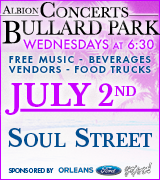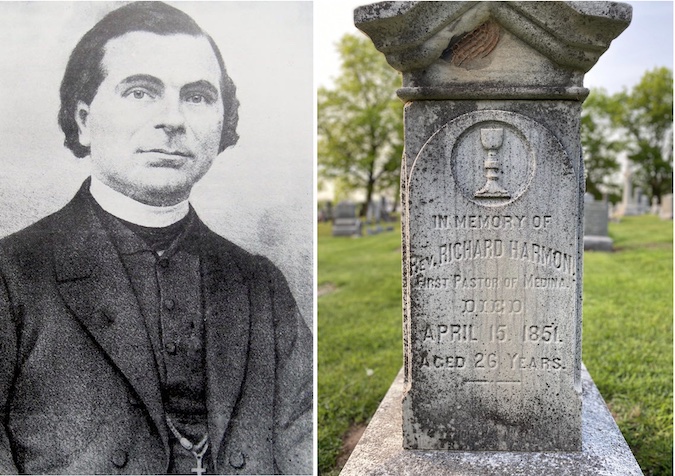In 1850, first resident priest appointed to serve Orleans, eastern Niagara
Rev. Richard Harmon, age 25, served wide territory from Somerset and Middleport, to Albion and Holley.
By Chris Busch
MEDINA – With the arrival of the Erie Canal on the Niagara Frontier came many of the first Catholics to the region. Sparsely settled only twenty years before, this new land was now poised for unbridled economic and spiritual growth.
With Catholics scattered across Niagara and Orleans counties, there were precious few opportunities for communal worship or to receive the Sacraments. The Catholic faithful were often hard-pressed for a priest to say Mass, and when a priest was available, he had to travel considerable distances and visited only occasionally.
Quoting Rev. Thomas Donahue, D.D. from his book, The History of the Catholic Church In Western New York, 1904:
“We can imagine how welcome the visit of a Catholic clergyman must be in the remote regions to the Catholic inhabitants. They sometimes waited for years to have their children baptized and to receive the sacraments, and the advent of a priest was the occasion of great gladness. He could say Mass for them in one of their homes, or in the court house; would baptize their children, would give them holy communion, and in their happy moments they would feel that they were again members of the Church from which they had been practically excluded.”
Such was the case on the Niagara Frontier. In 1832, there were a few Catholics in Medina, Middleport and Albion who were occasionally visited by priests from Lockport and sometimes Rochester. According to histories written on the subject, those visiting duties often fell to Rev. Michael McNamara, Rev. Patrick Costello and later, Rev. Bernard O’Reilly.
In 1832, Father Michael McNamara traveled from Rochester to say Mass for the Catholics of Medina. This was a highly anticipated event and the news spread like wildfire, not only among the village’s Catholics but among their Protestant friends as well. Fr. McNamara said Mass in the home of William Walsh and it was filled for the occasion.
Soon after, Reverend Bernard O’Reilly came from Rochester (and later, Lockport) and said Mass for the Catholics at the home of William O’Donnell on West Center Street.
Fr. O’Reilly was among the first to minister to Catholic families in Medina and the surrounding wide area. It was O’Reilly who officiated at the first Catholic marriage in Medina– that of James Kearney and Ann Kelly. The home of James Cullen located upon Laurel Hill was the scene of several meetings after that.
Outside of these uncertain visits of the priest, the people were obliged to send to Lockport or Rochester for a clergyman when they were sick, or to journey to one of these places when they wished to be married, have their children baptized or bury their dead.
Catholics in Medina and the surrounding communities continued to rely solely on infrequent visiting priests until upon the joyous day of Nov. 1, 1850 when The Most Rev. John Timon, Bishop of Buffalo, assigned a young priest from Ireland to Medina.
From Medina, Rev. Richard Harmon, age 25, was given charge of all the Catholic faithful in a wide territory from Somerset and Middleport, to Albion and Holley.
Again quoting Rev. Thomas Donahue, D.D. from his book, The History of the Catholic Church In Western New York, 1904:
“Then came Father Harmon, who by his gentle ways and zealous labors gained the affection of all, and is held in fond remembrance.”
Thus, Fr. Richard Harmon became the first resident pastor of Medina and the “father” of a newly formed family of the Catholic faithful. His first baptism was John Holoway, son of Mr. and Mrs. Joseph Holoway, Medina.
It is worthy to here note that the Diocese of Buffalo has recently undertaken a reorganization of parishes into ‘family’ groups to better minister to WNY Catholics with limited resources.
Ironically, the newly organized Family #11 of parishes encompasses the very same wide region as Fr. Harmon’s ‘family’ in 1850- the territory between Somerset and Holley. The Catholic Church in Eastern Niagara and Orleans Counties seems to have come full circle.
Like many young priests of that time, Fr. Harmon was a native son of Ireland, and completed his priestly formation in Europe.
Rev. Richard Harmon was the son of John H. and Hannah Lyons Harmon of County Carlow, Ireland. His parents, who never came to America, had thirteen children– four daughters and two sons who died in Ireland, and seven sons who settled in Indiana and Michigan.
Catherine Cooper, Orleans County Historian reflects:
“Acquiring a higher education in Ireland at that time was no easy task. The Penal Laws were somewhat less stringently enforced by then, but the memory remained of a time in the 16th and 17th centuries when Catholic priests had been hunted and churches destroyed. Catholics were not allowed to own land, vote, hold public office, and especially – receive a higher education.”
Harmon began his college studies in Carlow College and later attended a seminary in Sauns, (Southern) France where he was ordained a secular priest. From there, he traveled to America and to Buffalo. He was first stationed briefly at Lockport until his assignment to Medina in 1850.
With Mass often being said in a home, sometimes vestments were kept on site. A traveling priest had to carry what was needed to say Mass with him, including a ‘saddle chalice’– a simple chalice made in two pieces, making it easier to carry in a saddle bag. He may have also carried a small altar stone, perhaps made of oak, that was blessed by the bishop.
Fr. Harmon lived in the old Vandemark Hotel, Main and West Center (where Avanti’s now stands.) There was no rectory in Medina and only a small wood structure church. It was his task not only to minister to the faithful, but to build a permanent Catholic presence on this frontier in the communities under his care. He immediately set about doing just that.
Quoting Rev. Thomas Donahue, D.D. from his book, The History of the Catholic Church In Western New York, 1904, regarding Somerset–
“Fr. Harmon was the first priest to visit the vicinity of the present church at Somerset. He came in 1851, and was entertained as a guest by Mr. David Barker, a Protestant gentleman, on Saturday night, and on Sunday morning Father Harmon said Mass in the home of Michael Burke.”
And regarding Albion–
“Bishop Timon visited Albion in June, 1849, accompanied by Father Harmon of Medina. A site was selected for a church on North Main Street; and soon after work was begun on the building…”
From Albion, charge was given to Rev. J. L. Castaldi in 1865 of what became known as St. Mary’s of Holley.
As was the case with any circuit riding priest, Fr. Harmon came by horseback in the heat of summer and the cold of winter to minister to his flock across his wide pastorate. Fortunate indeed when the slow mule drawn packets of the canal could be used.
With Mass often being said in a home, sometimes vestments were kept on site. A traveling priest had to carry what was needed to say Mass with him, including a ‘saddle chalice’– a simple chalice made in two pieces, making it easier to carry in a saddle bag. He may have also carried a small altar stone, perhaps made of oak, that was blessed by the bishop.
According to an article from The Catholic Standard, authored by Stephanie A. T. Jacobe, Ph.D., June 4, 2021 entitled What did a circuit riding priest carry with him?:
“In many places the family would keep vestments and linens, but a traveling priest had to carry much of what he needed with him.
Before the Second Vatican Council, a lawful Roman Catholic Mass could only be celebrated on an altar consecrated by a bishop. It had to be a single piece of natural stone. The five crosses (at each corner of the stone) symbolize the five wounds of Christ and mark the places where a bishop would have consecrated the stone with oil. There was often also a small area where two relics were inserted into the stone. In the early Christian Church, portable altars could be made of wood.”
And so it likely was with Fr. Harmon– a man of gentle ways and zealous faith – a circuit riding priest with a God-given fervor and devotion to shepherd his faith-family on this new, vast and often harsh frontier.
Unfortunately, it was not meant to be that Fr. Harmon presided over his growing family for long. The zealous priest purchased some property in Medina with the thought of erecting a church, but this was not to happen.
Sadly, Fr. Harmon contracted a fever and died at the age of 26 in the spring of 1851 in the Vandermark Hotel in Medina. The young priest who had brought so much promise had been called home.
His body rests in the priests’ and sisters’ plot in St. Mary Cemetery, Medina. His grave is marked prominently with a beautiful, large monument denoting a pastor who was much beloved by his people. In all likelihood, the tremendous labors and hard life of a circuit riding priest with his arduous duties likely contributed to the fever that claimed his life. The faithful might say that perhaps he had been chosen by God for this one singular task– to establish God’s Church among the Catholic faithful in this region.
Fr. Harmon contracted a fever and died at the age of 26 in the spring of 1851 in the Vandermark Hotel in Medina. The young priest who had brought so much promise had been called home.
Whatever the case, Fr. Harmon died fervently shepherding his family.
Though his time in our region was brief, his impact was immense. Fr. Harmon accomplished much and sowed the seeds that soon grew into the faith family known today across Eastern Niagara and Orleans Counties.
The fruits of his labors still remain in the communities that were under his care – in Medina, Barker, Middleport and Albion from which grew parishes in Holley, and later Lyndonville and Kendall. They are a testament to the sacrifices made by Fr. Harmon and the faithful forebears of this region who through their perseverance, founded and grew a Catholic faith community through difficult times on a new frontier.
“Come to me, all you who labor and are burdened, and I will give you rest. Take my yoke upon you and learn from me, for I am meek and humble of heart; and you will find rest for yourselves. For my yoke is easy, and my burden light.” Matthew 11:28-30
Chris Busch is a member of Parish Family #11 in the Diocese of Buffalo and a communicant at Holy Trinity/St. Mary’s in Medina. He is also a retired history teacher from Lockport High School West.






































































